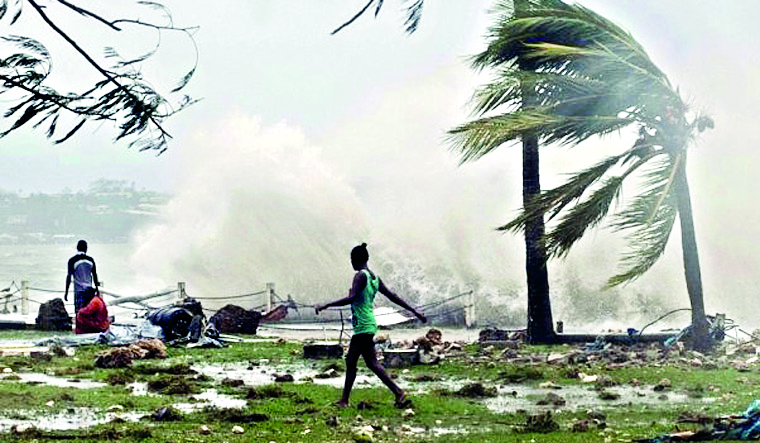Perils of the Sinking Shores
As oceans rise and storms grow stronger, the world’s coasts—home to over half the planet’s people—stand on the frontline of climate change, where survival demands urgent intervention, innovation, and a sense of equity

More than half of the world’s population lives along coasts, which are involved in a range of economic activities from traditional fishing to the hi-tech ports and fancy tourist spots. Some of the largest cities such as New York, Shanghai, Jakarta, Miami, Sydney, San Francisco, Mumbai, Los Angeles, Vancouver, Istanbul, Tokyo and Barcelona are located on coasts.
The adverse impact of climate change is being seen in varied geographies stretching from the coastal areas in Bangladesh to the small island states of the Pacific Ocean (Tuvalu, Vanuatu and Solomon Islands etc.), the Caribbean (Barbados, Grenada, St. Kitts and Nevis, St. Lucia etc.), and the Atlantic Ocean (Cabo Verde, Sao Tome, Principe etc.). Apart from the small island states, coastal communities across the world in rich countries such as the US, Australia, the UK, and Japan, as well as the developing countries of Asia and Africa such as India, Bangladesh, Kenya, Guinea, Mali, Mozambique and Sudan, are also impacted by climate change. While extreme weather events impact the rich as well as the poor, it is the poor who bear the brunt most because they don’t have adequate resources to adapt. For example, the fires that ravaged California were unprecedented and impacted the rich community, but were probably covered by insurance. Further, the rich have enough resources to rebuild. On the other hand, the poor in developing countries are worse off because the erratic and extreme weather affects the flora and fauna in the coastal areas, leading to increased economic risk for the communities dependent on fishing and related activities.
Coastal Areas: Need for Immediate Action
The most obvious threat to coastal areas is their vulnerability to rising sea levels, higher intensity and increased moisture-carrying capacity of storms, scarcity of freshwater, ingress of salty sea water into agricultural lands, and the increased economic risk for the population dependent on the coast. Another threat is the rising carbon dioxide in ocean water, which has led to acidification. This has caused the erosion of plankton and coral reefs, harmed marine life, and disrupted marine ecosystems in general.
According to the Intergovernmental Panel on Climate Change (IPCC), the rise in global ocean levels since the mid-19th century has been faster than the average over the previous 2,000 years. In the last 100 years, sea levels have been rising at an increasing rate. While levels rose by 1.7 mm per year between 1901 and 2010 (i.e., 17 cm over the century), the increase was 2.0 mm per year between 1971 and 2010, and 3.2 mm per year between 1993 and 2010. The main reasons for rising ocean levels are the melting of glaciers in Greenland and Antarctica, and the thermal expansion of water (as temperatures rise, water expands and occupies more space). The IPCC, in its Fifth Assessment Report published in 2014, estimated that ocean levels will rise between 17 cm and 38 cm by 2050, and between 26 cm and 82 cm by the year 2100. This will lead to flooding in coastal plains, and coastlines as we know them today will disappear. While densely populated countries such as Bangladesh and Indonesia, and the Small Island States in the Pacific, will be the worst hit, coastal cities elsewhere will also be severely affected.
Adaptation measures are essential to address the adverse effects of rising sea levels and intense cyclones and storms. Some of these measures include better coastal management and planning, creating more resilient infrastructure, widespread use of technology such as early warning systems, creation of evacuation infrastructure such as flat vacant spaces on highland, capacity building of coastal communities, and diversifying economic activities in coastal areas. There is much to learn from the Netherlands, a low-lying country that has been dealing with rising sea levels for years. They have done so through the creation of protective dykes and levees, innovative hydraulic structures, storm surge barriers, and multiple sources of freshwater.
Conclusion
Given that a large number of people live along coastlines, it is important to adopt adaptive measures to confront the adverse consequences of climate change—such as rising sea levels and the increasing frequency and intensity of storms and cyclones. This can be achieved through the imaginative use of technology, capacity building of coastal communities, and the creation of resilient infrastructure.
The writer is Additional Chief Secretary, Department of Cooperation, Government of West Bengal



